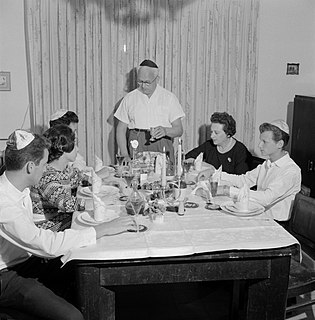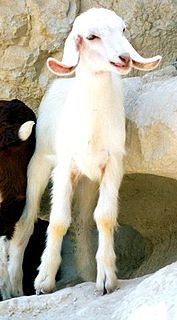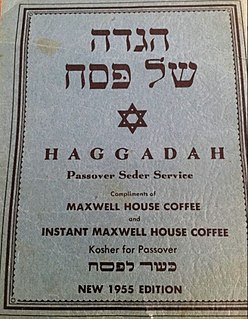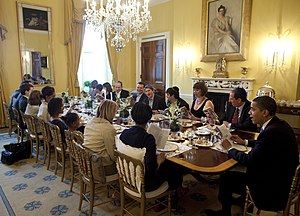
Matzah or matzo is an unleavened flatbread that is part of Jewish cuisine and forms an integral element of the Passover festival, during which chametz is forbidden.

Passover, also called Pesach, is a major Jewish holiday that celebrates the Biblical story of the Israelites escape from slavery in Egypt, which occurs on the 15th day of the Hebrew month of Nisan, the first month of Aviv, or spring. The word Pesach or Passover can also refer to the Korban Pesach, the paschal lamb that was offered when the Temple in Jerusalem stood; to the Passover Seder, the ritual meal on Passover night; or to the Feast of Unleavened Bread. One of the biblically ordained Three Pilgrimage Festivals, Passover is traditionally celebrated in the Land of Israel for seven days and for eight days among many Jews in the Diaspora, based on the concept of yom tov sheni shel galuyot. In the Bible, the seven-day holiday is known as Chag HaMatzot, the feast of unleavened bread (matzo).

The Passover Seder is a ritual feast at the beginning of the Jewish holiday of Passover. It is conducted throughout the world on the eve of the 15th day of Nisan in the Hebrew calendar. The day falls in late March or in April of the Gregorian calendar; Passover lasts for seven days in Israel and eight days outside Israel. Jews traditionally observe one seder if in Israel and two if in the Jewish diaspora. The Seder is a ritual involving a retelling of the story of the liberation of the Israelites from slavery in ancient Egypt, taken from the Book of Exodus (Shemot) in the Jewish Torah. The Seder itself is based on the Biblical verse commanding Jews to retell the story of the Exodus from Egypt: "You shall tell your child on that day, saying, 'It is because of what the LORD did for me when I came out of Egypt.'" At the seder, Jews read the text of the Haggadah, an ancient Tannaitic work. The Haggadah contains the narrative of the Israelite exodus from Egypt, special blessings and rituals, Talmudic commentaries, and Passover songs.

The Haggadah is a Jewish text that sets forth the order of the Passover Seder. According to Jewish practice, reading the Haggadah at the Seder table is a fulfillment of the mitzvah to each Jew to tell their children the story from the Book of Exodus about God bringing the Israelites out of slavery in Egypt, with a strong hand and an outstretched arm.

Kiddush, literally, "sanctification", is a blessing recited over wine or grape juice to sanctify the Shabbat and Jewish holidays. Additionally, the word refers to a small repast held on Shabbat or festival mornings after the prayer services and before the meal.
Hallel is a Jewish prayer, a verbatim recitation from Psalms 113–118 which is recited by observant Jews on Jewish holidays as an act of praise and thanksgiving.

Charoset, haroset, or charoises is a sweet, dark-colored paste made of fruits and nuts eaten at the Passover Seder. According to the Talmud its color and texture are meant to recall mortar which the Israelites used when they were enslaved in Ancient Egypt as mentioned in Tractate Pesahim of the Talmud, which says " The word charoset comes from the Hebrew word cheres ".

Dayenu is a song that is part of the Jewish holiday of Passover. The word "dayenu" means approximately "it would have been enough", "it would have been sufficient", or "it would have sufficed". This traditional up-beat Passover song is over one thousand years old. The earliest full text of the song occurs in the first medieval haggadah, which is part of the ninth-century Seder Rav Amram. The song is about being grateful to God for all of the gifts given to the Jewish people, such as taking them out of slavery, giving them the Torah and Shabbat, and had God only given one of the gifts, it would have still been enough. This is to show much greater appreciation for all of them as a whole. The song appears in the haggadah after the telling of the story of the exodus and just before the explanation of Passover, matzah, and the maror.

The Passover Seder plate is a special plate containing symbolic foods eaten or displayed at the Passover Seder. The purpose of the Passover Seder plate is to show all the foods that perpetuate and emphasize the ideas of the people of Israel, and are designed to express the uniqueness of the Seder. Another idea is to keep the foods close and ready for Seder night.

Pesachim, also spelled Pesahim, is the third tractate of Seder Moed of the Mishnah and of the Talmud. The tractate discusses the topics related to the Jewish holiday of Passover, and the Passover sacrifice, both called "Pesach" in Hebrew. The tractate deals with the laws of matza and maror, the prohibitions against owning or consuming chametz (leaven) on the festival, the details of the Paschal lamb that used to be offered at the Temple in Jerusalem, the order of the feast on the first evening of the holiday known as the Passover seder, and the laws of the supplemental "Second Pesach".

Afikoman based on Greek epikomon [ἐπὶ κῶμον] or epikomion [ἐπικώμιον], meaning "that which comes after" or "dessert"), a word originally having the connotation of "refreshments eaten after the meal", is now almost strictly associated with the half-piece of matzo which is broken in two during the early stages of the Passover Seder and set aside to be eaten as a dessert after the meal.
Passover songs are songs from the seder, the festive meal associated with the Jewish festival of Passover.

Chad GadyaorHad Gadya is a playful cumulative song in Aramaic and Hebrew. It is sung at the end of the Passover Seder, the Jewish ritual feast that marks the beginning of the Jewish holiday of Passover. The melody may have its roots in Medieval German folk music. It first appeared in a Haggadah printed in Prague in 1590, which makes it the most recent inclusion in the traditional Passover seder liturgy.

Ma Nishtana, are the first two words in a phrase meaning "Why is tonight different from all other nights?" The phrase appears at the beginning of each line of The Four Questions, traditionally asked via song by the youngest capable child attending Passover Seder.
In 1986, the Israeli embassy in Kathmandu organized a Passover celebration as a service to the 7,000 Israelis who visit Nepal annually. The celebration was taken over in 1999 by the Chabad (/ħabad/) movement, a Hassidic Jewish movement that specializes in outreach to nonobservant Jews. Prior to 1986, there was no organized practice of Judaism in Nepal, and there is no native Jewish community.
In Judaism, when the Eve of Passover falls on Shabbat, special laws regarding the preparation for Passover are observed.

Ha Lachma Anya is a declaration that is recited at the beginning of the Magid portion of the Passover Seder. Written in Aramaic, the recitation serves as the first explanation of the purpose of the matzo during the Seder.

The Maxwell House Haggadah is an English-Hebrew Passover Haggadah introduced by the Maxwell House company as a marketing promotion in 1932 and printed continuously since that time. With over 50 million copies in print, it is the best known and most popular Haggadah among American Jews, and is considered a cultural icon. It is used at Passover Seders in homes, schools, senior centers, prisons, and the United States Army, and was the edition used by President Obama and his guests at the White House Passover Seder conducted yearly from 2009 to 2016. In 2011 a new English translation replaced archaic phrases in the original and also incorporated gender-neutral language.

The Birds' Head Haggadah is the oldest surviving illuminated Ashkenazi Passover Haggadah. The manuscript, produced in the Upper Rhine region of Southern Germany in the early 14th century, contains the full Hebrew text of the Haggadah, a ritual text recounting the story of Passover – the liberation of the Israelites from slavery in ancient Egypt – which is recited by participants at a Passover Seder. The text is executed in block calligraphy and accompanied by colorful illustrations of Jews performing the Seder practices and reenacting Jewish historical events. The Birds' Head Haggadah is so called because all Jewish men, women, and children depicted in the manuscript have human bodies with the faces and beaks of birds. Non-Jewish and non-human faces are blank or blurred. Numerous theories have been advanced to explain the unusual iconography, usually tied to Jewish aniconism. The Haggadah is in the possession of the Israel Museum in Jerusalem, where it is on permanent exhibition.
Le'Or is a 501(c)(3) organization in Portland, Oregon. It was founded in 2015 by Roy and Claire Kaufmann. The group publishes a haggadah via its website that substitutes cannabis for lettuce in the seder plate and promotes consumption of cannabis as part of the sacred rituals of Pesach (Passover). The haggadah includes the "Ten Plagues of the Drug War" and was meant to inspire discussion about the meaning of bondage in the modern age of mass incarceration and the war on drugs.


















